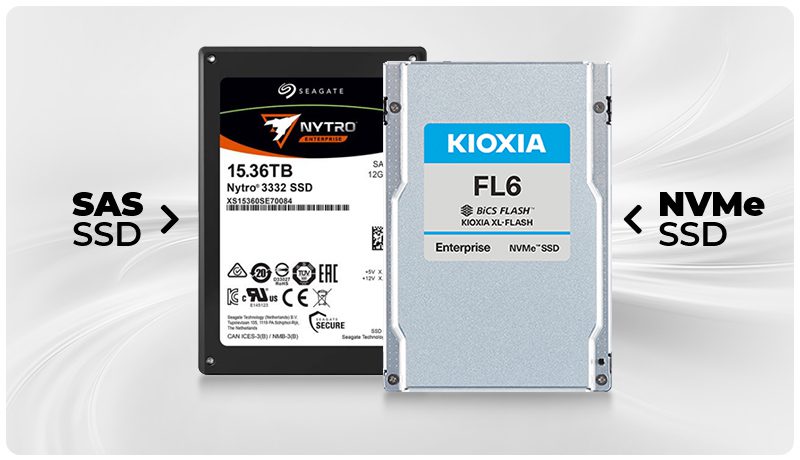Conversations with our partners, customers, or people we meet at branch events are a strong motivation and basis for analyzing new technological solutions. Discussions about different approaches to data storage generate new ideas but often require us to be open to meeting future expectations. Usually, doubts arise during such talks. Although these matters seem simple, they force us to stop for a moment and analyze the pros and cons of choosing the proper data storage infrastructure solutions for a given business model. One issue that has recently come up in conversation with partners is one we want to address today. While this seems simple on the surface, it also requires some thought, and variables such as performance, speed and reliability are key considerations here. This raises the question of flash drives and their application.
All-NVMe Data Storage System vs. all-SAS SSD Data Storage System: When and why will a particular solution suit your business better? And is this the best solution possible?
SAS SSD vs NVMe – Features Comparison
Looking at the characteristics of flash drives, we can compare them in terms of the types of functionalities they exhibit:
[attc id=’18’]
*source amazon. com
NVMe Data Storage System Appliance
NVMe data storage systems represent a significant technological shift in data storage, offering outstanding performance and low-latency solutions for various demanding applications.
Within database systems, the speed and efficiency of NMVes revolutionize OLTP and OLAP (Online Transaction Processing and Online Analytical Processing), catalyzing transaction processing acceleration and enabling real-time analytics for informed decision-making. In big data analytics, NVMe cluster systems are catalysts for innovation, accelerating data warehousing tasks and empowering real-time analytics applications with faster data processing and analysis capabilities.
The versatility of NVMe extends into High-Performance Computing (HPC), where these systems deliver exceptional I/O throughput and minimal latency, powering complex simulations, modeling endeavors, and data-intensive applications like weather forecasting and genomics research. Virtualization and containerization also reap significant benefits from NVMe’s heightened performance and responsiveness, elevating the efficiency of virtualized environments and enabling swift deployment and scaling of containerized workloads.
In the field of high-performance storage systems, NVMe performance is evident, facilitating all-flash arrays and software-defined storage solutions that offer unparalleled levels of speed and scalability. Additionally, NVMe cluster systems enhance the agility and reliability of CDNs (Content Delivery Networks), bolstering responsiveness and ensuring timely content delivery to end-users through efficient edge caching and content distribution mechanisms.
SAS SSD Data Storage System Appliance
All-flash SAS SSD data storage systems serve diverse enterprise applications, delivering high-performance storage solutions with reliability and scalability.
In virtualization and consolidation, SAS SSDs power VDI environments, enhancing VM boot times, application responsiveness, and user experience. They are also well-suited for hosting virtualized workloads in server virtualization scenarios, providing consistent performance and reliability for web servers, application servers, and databases.
For enterprise applications such as ERP (Enterprise Resource Planning) and CRM (Customer Relationship Management) systems, SAS SSDs accelerate database transactions and improve application responsiveness, facilitating faster data access and processing. In content management and media processing, SAS SSDs optimize Content Management Systems (CMS) platforms by reducing content retrieval times and enabling faster data processing and delivery. They also excel in media processing and editing environments, offering high throughput and reliability for editing, rendering, and streaming media files.
In business intelligence and analytics, SAS SSDs are pivotal in accelerating data loading, querying, and reporting tasks in BI and data warehousing environments, enabling faster decision-making and analysis. They also enhance the performance of batch processing and ETL (Extract, Transform, Load) jobs by reducing data transfer times and accelerating data transformation tasks.
SAS SSDs serve as high-performance storage tiers in high-capacity storage applications like backup and archival storage, providing fast access to frequently accessed data and reducing backup windows. They complement high-capacity HDD storage in tiered storage architectures, enabling hot data to be stored on SSDs for faster access while cold data is stored on HDDs for cost-effectiveness.

SAS SSD – NVMe Hybrid: Data Storage Solution for Future Business Demands
Exploring innovative solutions in data storage technology is imperative for optimizing performance and efficiency in modern IT environments. An intriguing approach lies in the fusion of SSD and NVMe technologies. This hybrid data storage solution not only addresses the need for cost optimization and space efficiency through SSDs but also maximizes performance with NVMe drives, particularly in caching mechanisms.
Open-E recently certified a groundbreaking solution in partnership with Dadeh Rayanesh Abri Pardis, which may shed some light on the article’s subject. The Pardis HP DL380 Gen10 HA All-Flash Cluster is now certified for seamless integration with Open-E JovianDSS. Tailored for database and virtualization environments, this cluster ensures uninterrupted and immediate data access. Leveraging the strengths of SAS SSD and NVMe drives, we’ve equipped the unit for swift multitasking, harnessing the speed and efficiency of flash drives to optimize performance. The system’s speed is assured with an All-Flash SSD array, further enhanced by an NVMe Write Log, elevating performance to new heights.
When planning the IT infrastructure development and maintenance strategy, CEOs, CTOs, and IT admins face the challenge of choosing between implementing the latest data storage technologies or relying on older but more proven hardware. By applying NVMe data storage systems, businesses can unlock unprecedented levels of performance and efficiency across markets. However, these costs are high, so a relevant strategy is needed to weigh between market demands and balanced expenses tailored to certain business models. With the increasing desire for faster and more reliable storage solutions, the integration of SSD and NVMe technologies is becoming paramount. The previously mentioned certification highlights the importance of NVMe in driving innovation and propelling companies towards their strategic goals and great SSD reliability compromised with lower costs.





Leave a Comment